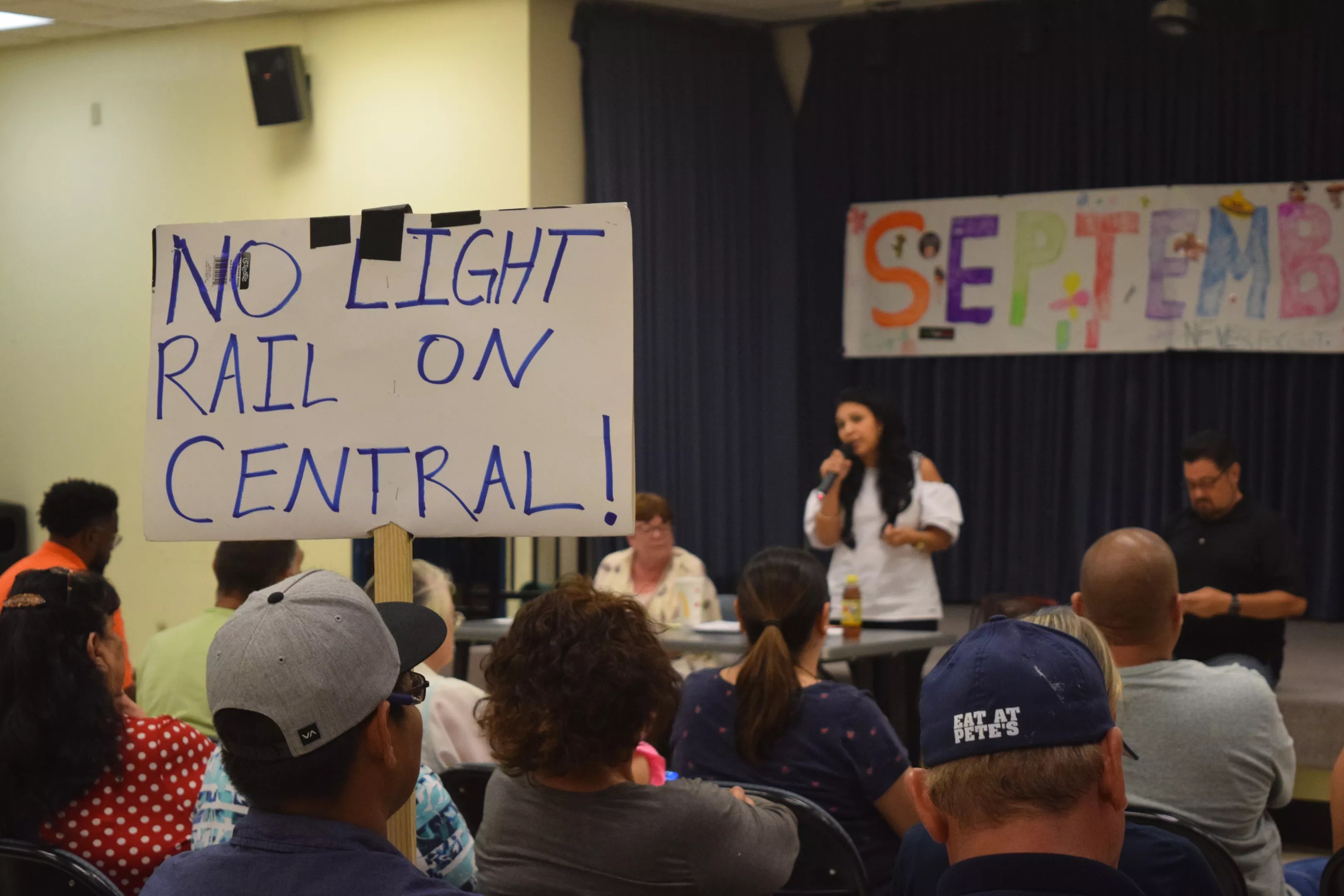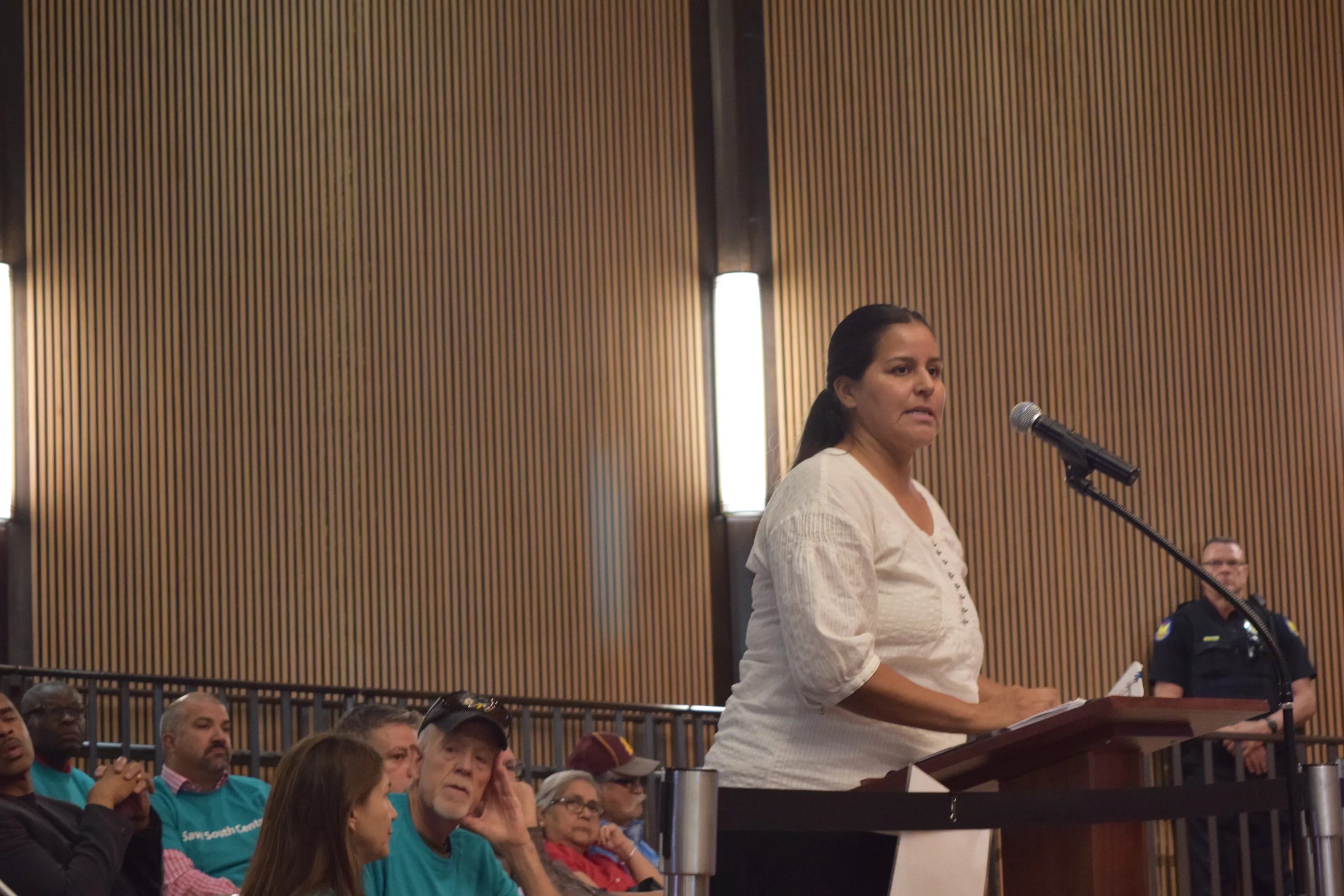
Joseph Flaherty

Audio By Carbonatix
The planned light rail extension to South Phoenix lives – for now.
The Phoenix City Council voted to move ahead with the embattled South Central light rail line using the original, two-lane design at a special meeting on Wednesday.
The motion, which passed 6-2, directed staff to take into account the needs of the small business community as the project rolls forward.
Prior to the vote, interim Mayor Thelda Williams said that light rail is a necessary piece of the transit map in Phoenix. And, putting it bluntly, Williams said, “I’ve always thought South Phoenix got the shaft.”
Per the initial design, the project was to reduce Central Avenue to two lanes, one in each direction. But a vocal community of business owners said that light rail would wreck their livelihood. Their group, 4 Lanes or No Train, began in opposition to the two-lane lane design but is now opposed to light rail, full stop.
Acknowledging their demands, in June, the City Council directed transit authority Valley Metro and city staff to study the possibility of maintaining four lanes of traffic, wherever possible, on a 5.5 mile stretch of South Central Avenue from downtown to Baseline Road. They also told Valley Metro to conduct more outreach to inform residents and get the community’s input.
In order to receive $595 million in funding from the Federal Transit Administration, the South Central extension must stick to a strict timeline. The deadline to enter into the engineering phase of the project is November.
Valley Metro CEO Scott Smith warned the City Council at the meeting that any deviation from the timeline could remove the project from the federal grant queue.
Smith told council members that a new, four-lane configuration would likely require a new environmental assessment. This would delay the project and increase the chance that the project will be removed from the federal grant process, risking crucial dollars from the federal Capital Investment Grant program.
“If we are removed from the federal list, this project is on life support,” Smith told the Council. “You’re talking one-in-a-million chances to get back in,” he added.
The Trump administration, Smith noted ominously, is not fond of funding rail projects, a factor which makes any delay more dangerous for the South Central extension.
During the public comment section, residents sparred over whether light rail will be a boon or a boondoggle to South Phoenix.
An often-neglected part of the city with historic black and Latino communities, South Phoenix deserves the benefits of light rail, some people said. The rail system will serve as a vital link to downtown for residents who don’t have a car, they argued. “The people who complain the most about light rail are the people who’ve never used it,” one citizen said at the podium.
Others said that by installing a permanent, inflexible rail line, the city will destroy businesses and wreck the flow of traffic.

Celia Contreras, owner of Tony’s Window Tinting on Central Avenue, is leading an anti-light rail coalition of business owners in the grassroots group 4 Lanes or No Train.
Joseph Flaherty
“This light rail will fundamentally change South Phoenix forever,” resident Eduardo Sanchez told the Council. “It will effectively split South Phoenix in two. It will bring crime and gentrification, and it would displace many residents along Central.”
Libertarian mayoral candidate Nicholas Sarwark, a light rail opponent, told the Council that Central Avenue will be locked into rail for decades to come. Businesses along Central Avenue will close, Sarwark said.
“There’s going to be winners and losers,” Sarwark said. “Valley Metro and the contractors that work on it will win, and the businesses that have already built this community will lose.”
But as public transit advocates consistently reminded their foes, the South Central extension has been a long time coming.
The City Council approved the two-lane design during a 2014 vote, and voters citywide approved a long-term transportation funding plan that included more light rail in a 2015 referendum, Proposition 104. As a result of an accelerated timeline – also approved by the Council, in January 2016 – trains are supposed to start running between downtown and South Phoenix by 2023.
Dueling political committees are prepared to continue the fight: Building a Better Phoenix, which represents the anti-light rail business owners from 4 Lanes or No Train, is up against Arizonans for Transportation, another new group dedicated to advancing the pro-light rail agenda.
Both groups have political ties.
As the Arizona Republic pointed out yesterday, Building a Better Phoenix is tied to a Koch-affiliated organization, the Arizona Free Enterprise Club. Scot Mussi, the president of the Enterprise Club, registered the committee’s domain name.
Meanwhile, the pro-light rail group Arizonans for Transportation is led by political consultant Lisa Fernandez – she has campaigned for both Stanton and Gallego – plus two others who work for transportation infrastructure companies AECOM and HDR.
Another important factor contributing to the light rail chaos are the political shockwaves from former mayor Greg Stanton’s resignation to run for Congress in May. Stanton’s departure led to the resignations of two liberal, pro-light rail council members, Kate Gallego and Daniel Valenzuela, who are currently running for mayor.
Under Williams’ term as interim thus far, conservatives Sal DiCiccio and Vice Mayor Jim Waring have gained ground, pushing to kill future expansions of light rail at every opportunity.
Nevertheless, at Wednesday’s meeting other council members pushed back on the anti-light rail crusade.
Newly appointed council member Vania Guevara, whom other members elected to replace Valenzuela in District 5, supported the two-lane design, arguing that public transit like light rail is part of being a world-class city.
Guevara said that she recently met with South Phoenix business owners and residents who have been working with Valley Metro to provide input on the extension for several years. One of them told Guevara that they feel the community’s fingerprints are all over the project.
“That’s how we build the city of the future,” Guevara said at the meeting. “We deeply engage our residents at every step of the process, and put their vision into action.”